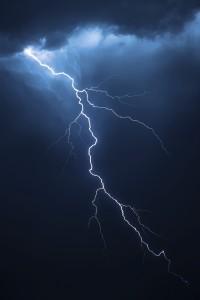It’s summer time, the most likely time of year for surprise thunderstorms. All thunderstorms are dangerous and every thunderstorm produces lightning. Most lightning deaths and injuries occur when people are caught outdoors in the summer months during the afternoon and evening. Did you know that even if a storm is as much as 10 miles away, lightning can still strike in your area? On average in the U.S., lightning kills 51 people and injures hundreds more. Although most survive, people struck by lightning often report a variety of long-term, debilitating symptoms.
 According to the National Weather Service, if you’re outside while thunderstorms and lightning are occurring in your area, you should:
According to the National Weather Service, if you’re outside while thunderstorms and lightning are occurring in your area, you should:
. Get inside a home, building, or hard top automobile (not a convertible). Although you may be injured if lightning strikes your car, you are much safer inside a vehicle than outside. Avoid isolated sheds or other small structures in open areas.
. Avoid natural lightning rods such as a tall, isolated tree in an open area. Seek shelter in a low area under a thick growth of small trees.
. Avoid hilltops, open fields, the beach or a boat on the water.
. If you’re in a boat, get off the water. Get to land and find shelter immediately.
. Avoid contact with anything metal like motorcycles, golf carts, golf clubs, and bicycles.
. Do not lie on concrete floors and do not lean against concrete walls.
. If you are driving, try to safely exit the roadway and park. Stay in the vehicle and turn on the emergency flashers until the heavy rain ends. Avoid touching metal or other surfaces that conduct electricity in and outside the vehicle. The steel frame of a hard-topped vehicle provides increased protection if you are not touching metal.
Remember, rubber-soled shoes and rubber tires provide NO protection from lightning.
All content of this newsletter is intended for general information purposes only and is not intended or implied to be a substitute for professional medical advice, diagnosis or treatment. Please consult a medical professional before adopting any of the suggestions on this page. You must never disregard professional medical advice or delay seeking medical treatment based upon any content of this newsletter. PROMPTLY CONSULT YOUR PHYSICIAN OR CALL 911 IF YOU BELIEVE YOU HAVE A MEDICAL EMERGENCY.
